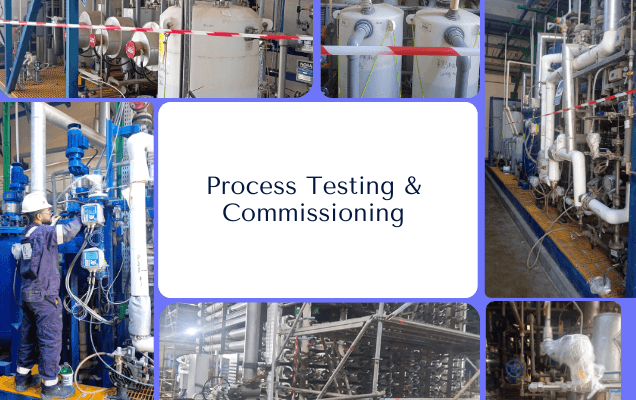
Process Testing and Commissioning involve the verification and validation of process systems and equipment, such as reactors, distillation columns, heat exchangers, and control systems, to ensure they operate according to design specifications. This includes testing the functionality of equipment, calibrating instruments, and verifying control loops and safety systems. The goal is to ensure the process runs efficiently, safely, and within the required operational parameters. Commissioning ensures that all systems are integrated, perform as expected, and are ready for full-scale production or operation.
At SSE Multinational, we believe that clear communication and expertise are key to successful project outcomes. That’s why we’re here to address any questions you may have—whether about our commissioning services, project strategies, or customized solutions. Our team of industry experts is dedicated to providing the insights and guidance you need every step of the way, ensuring confidence and clarity throughout your project journey. Reach out, and let us cover your questions with the answers you deserve.
The purpose is to verify that all process systems and equipment, such as reactors, pumps, heat exchangers, and control systems, are installed correctly, tested, and function as designed. The goal is to ensure safe, efficient, and reliable operation before full-scale production begins.
The first step is a review of the design documentation (P&IDs, control system diagrams, etc.) to ensure that all specifications are accurate and that the process systems have been installed according to the design.
Common tests include:
Loop checking is the process of verifying the functionality of control loops between instruments and equipment to ensure that process variables, such as temperature, pressure, and flow, are controlled within the specified limits and respond as expected to control signals.
System integration ensures that all systems (mechanical, electrical, and instrumentation) work together seamlessly. Proper integration of these systems is crucial for smooth and coordinated operation, preventing issues such as control malfunctions or safety risks.
Performance testing involves running the system under normal operating conditions to confirm it operates within the required production rates, efficiency, and quality standards. This may include full load testing, energy efficiency testing, and monitoring process parameters to verify optimal performance.
Safety systems such as emergency shutdown (ESD) systems, relief valves, and interlocks are thoroughly tested to ensure they operate correctly under emergency conditions. This includes verifying that safety alarms trigger and that relief valves open/close at the correct pressures to protect the system.
Calibration ensures that instruments (e.g., pressure transmitters, flow meters) provide accurate measurements by adjusting them to a known standard. This is critical for maintaining control over the process and ensuring that the system operates within the required specifications.
Hydrostatic testing is used to verify the strength and integrity of pipes, tanks, and other pressurized equipment. It involves filling the system with water and pressurizing it to detect leaks or weaknesses in the structure that could compromise the system’s safety or operation.
The final steps include completing all performance tests, ensuring that the system is fully integrated, preparing final documentation (test results, certifications, and manuals), and providing operator training. Once everything is verified and operational, the system is handed over to the client for use.
Process optimization involves monitoring and adjusting key process parameters, such as temperature, pressure, and flow rates, to ensure that the system operates at maximum efficiency and within optimal production conditions. This may include fine-tuning control systems and equipment settings.
Common challenges include:
If an issue is identified, the commissioning team will troubleshoot and resolve the problem, which may involve repairs, re-calibration, or adjustments. The system must pass all required tests before it can be considered fully commissioned and ready for operation.
Safety is ensured by following strict safety protocols, conducting risk assessments, and ensuring that all safety systems (such as emergency shutdowns and relief valves) are tested. Personnel are also trained on proper safety measures, and proper protective equipment is used throughout the commissioning process.
The duration varies depending on the complexity and size of the project. Small systems might be commissioned in a few weeks, while larger, more complex processes could take several months. Planning, resources, and coordination play key roles in determining the timeline.
